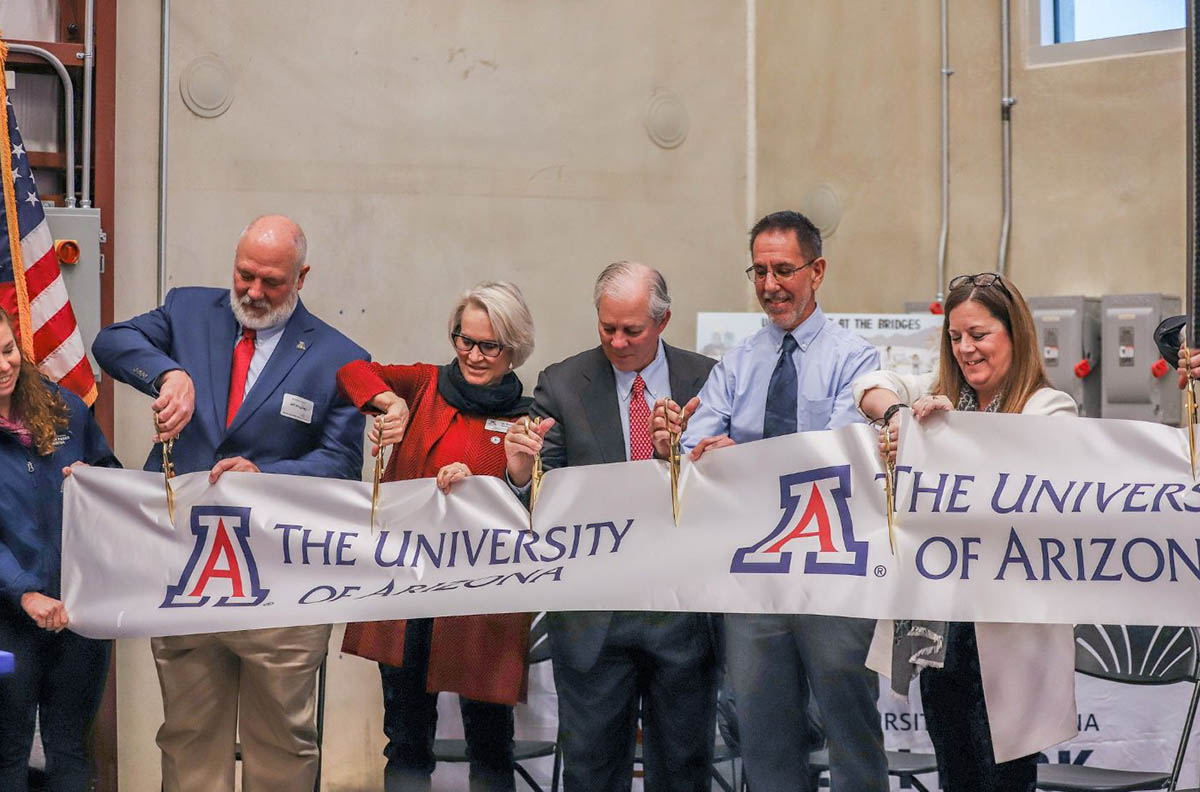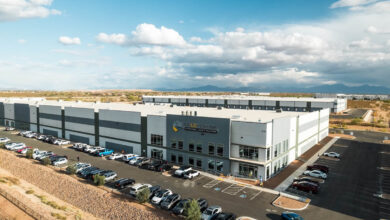
Mission Integration Lab Launched at UA Tech Park at the Bridges
The University of Arizona Office of Research, Innovation and Impact launched its new research building in the UA Tech Park at The Bridges on Dec. 12.
The Mission Integration Lab expands research capacity to tackle grand space-based challenges and position the UArizona as one of only a handful of institutions that can run top-dollar missions.
The lab accommodates balloon-borne astronomy, which fills an important niche between ground-based observatories and space telescopes, providing an ideal way to deploy telescopes and other instruments to altitudes where they experience less interference from the Earth’s atmosphere. Modern balloon-borne observatories offer space-like views of the universe in missions that require a fraction of the time and cost of a full space mission. These missions are also a platform to test cutting-edge technologies that will define future orbital missions.
The world-class research enterprise at UArizona is ranked among the top 20 public universities nationwide with more than $800 million in annual research activity. This innovative facility makes the UArizona even more competitive for top-dollar research missions. The New Economy Initiative Funding enabled the building of this cutting-edge facility that will focus on research initiatives to help the university’s $1 billion research goal and are also consistent with both land-grant mission and purpose as one of the nation’s top research universities.
“Not only will this new facility enable the UA to remain at the forefront of Research I institutions for astronomy, but it will enable us to run the kind of space-based research and mission operations that are significant when working with NASA, as well as key industry players like SpaceX, Boeing, Lockheed Martin, and others. said Betsy Cantwell, UArizona’s senior VP of research and innovation.
The lab, a tall, hangar-like “high bay,” serves as a test bed for new technology enabling researcher to be able to prepare and test stratospheric balloon payloads and other space payloads as they near flight and seed new testing and evaluation protocols for improved efficiency. Here researchers and students can work on instruments, telescopes and high-altitude balloon technology to build and test hardware for experiments and missions designed to fly at extremely high altitudes sometimes referred to as the “edge of space,” a fuzzy, ill-defined transition zone between Earth’s atmosphere and space. The new building will allow for additional space to grow research programs and partnerships for students and faculty, federal agencies and corporations to advance balloon-based astronomy frontiers.
Carol Stewart, associate VP of Tech Parks Arizona, pointed out, “The UA Tech Park was designed to develop purpose-built environments for university, industry, and government entities to come together to advance leading-edge technologies. This is the first research-specific building up at the UA Tech Park at The Bridges.”
“Concord was pleased to be a part of the successful Mission Integration Lab project at the UA Tech Park at the Bridges. This project was a team effort by UArizona, Swaim Architects and Concord to produce a unique lab space that supports the research mission of the scientific community. Creative work to overcome supply chain challenges and deliver the project on time highlighted the close cooperation and effective communication of the entire project team,” said Kevin Illige, project manager for Concord General Contracting.
The grand opening event was attended by over a hundred business leaders, government officials, community members, innovators and UArizona leaders. The ceremony included ribbon-cutting led by UArizona President Dr. Robert C. Robbins and included Cantwell, Stewart, Jeff Kingsley, associate director of Steward Observatory, Dan Marrone, an astronomy professor with the Steward Observatory, and Illige.
The event included balloon-borne mission equipment on display:
- The Terahertz intensity mapper, or TIM, a NASA-funded balloon mission designed to create a giant map of galaxies over 5 billion years of cosmic history which relies on an imaging spectrometer capable of detecting extremely faint galaxies in the “cosmic afternoon,” the time when star formation in the universe was slowing down from its peak 10 billion years ago.
- GUSTO, short for Galactic/Extragalactic ULDB Spectroscopic Terahertz Observatory, a NASA-funded mission to carry an infrared telescope to study the lifecycle of stars in the interstellar medium, from their birth out of condensing molecular clouds in stellar nurseries to their evolution and death, reseeding the interstellar medium with the ingredients that will form new stars.
As well as the unveiling of the “Seeds of Wonder” mural which was commissioned by the University of Arizona SXSW Wonder House project, and painted by UArizona alum Jessica Gonzales. This canvas and acrylic mural exemplify people’s yearning to look to the skies for inspiration and is about harnessing passions and following dreams. The color palette represents stunning Arizona sunsets and celebrates the beauty of the desert as well as the stargazing-friendly night skies.





